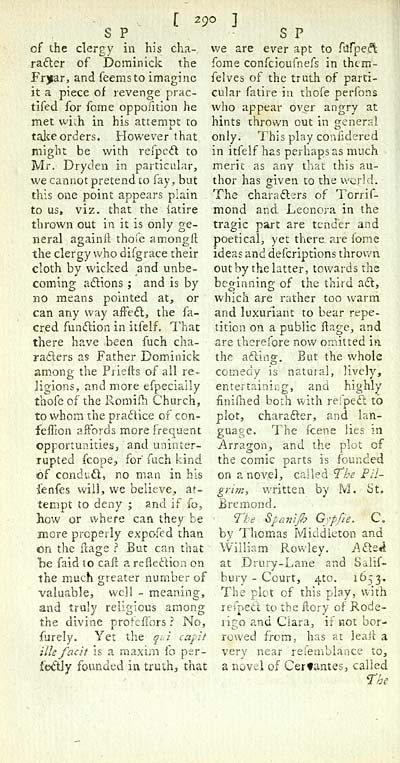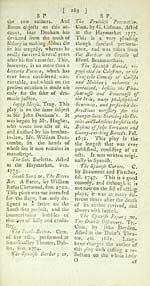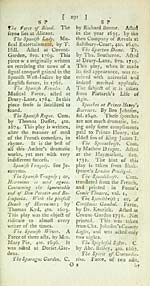Glen Collection of printed music > Printed text > New theatrical dictionary
(304) Page 290
Download files
Complete book:
Individual page:
Thumbnail gallery: Grid view | List view

S P
of the clergy in his cha-
racter of Dominick the
Fryar, and feemsto imagine
it a piece of revenge prac-
tifed for fome oppofition he
met wkh in his attempt to
take orders. However that
might be with refpeet to
Mr. Dryden in particular,
we cannot pretend to fay, but
this one point appears plain
to us, viz. that the iatire
thrown out in it is only ge-
neral againft thofe amongfl:
the clergy who difgrace their
cloth by wicked and unbe-
coming actions ; and is by
no means pointed at, or
can any way affect, the fa-
cred function in itfelf. That
there have been fuch cha-
racters as Father Dominick
among the Priefts of all re-
ligions, and more efpecially
thofe of the Romifh Church,
to whom the practice of con-
fefhon affords more frequent
opportunities, and uninter-
rupted fcope, for' fuch kind
of conduct, no man in his
fenfes will, we believe, at-
tempt to deny ; and if fo,
how or where can they be
more properly expofed than
on the ftage ? But can that
be faid to cafr a reflection on
the much greater number of
valuable, well - meaning,
and truly religious among
the divine profeffors ? No,
furely. Yet the qui capit
illefacit is a maxim fo per-
fectly founded in truth, that
[ 290 ]
S P
we are ever apt to fufped
fome confeioufnefs in them-
felves of the truth of parti-
cular fatire in thofe perfons
who appear over angry at
hints thrown out in general
only. This play confidered
in itfelf has perhaps as much
merit as any that this au-
thor has given to the world.
The characters of Torrif-
mond and Leonora in the
tragic part are tender and
poetical, yet there, are fome
ideas and defcriptions thrown
out by the latter, towards the
beginning of the third act,
which are rather too warm
and luxuriant to bear repe-
tition on a public ftage, and
are therefore now omitted in
the acting. But the whole
comedy is natural, lively,
entertaining, and highly
finifhed both with refpeet to
plot, character, and lan-
guage. The fcene lies in
Arragon, and the plot of
the comic parts is founded
on a novel, called; T, be Pil-
grim, written by M. St.
Bremond.
The Spanijb Gjpjit. C.
by Thomas Middleton and
William Rowley. A£tz$.
at Drury-Lane and Salis-
bury - Court, 41:0. 1653.
The plot of this play, with
refpeet to the ftory of Rode-
rigo and Clara, if not bor-
rowed from, has at leaft a
very near refemblance to,
a novel of Certantes, called
The
of the clergy in his cha-
racter of Dominick the
Fryar, and feemsto imagine
it a piece of revenge prac-
tifed for fome oppofition he
met wkh in his attempt to
take orders. However that
might be with refpeet to
Mr. Dryden in particular,
we cannot pretend to fay, but
this one point appears plain
to us, viz. that the iatire
thrown out in it is only ge-
neral againft thofe amongfl:
the clergy who difgrace their
cloth by wicked and unbe-
coming actions ; and is by
no means pointed at, or
can any way affect, the fa-
cred function in itfelf. That
there have been fuch cha-
racters as Father Dominick
among the Priefts of all re-
ligions, and more efpecially
thofe of the Romifh Church,
to whom the practice of con-
fefhon affords more frequent
opportunities, and uninter-
rupted fcope, for' fuch kind
of conduct, no man in his
fenfes will, we believe, at-
tempt to deny ; and if fo,
how or where can they be
more properly expofed than
on the ftage ? But can that
be faid to cafr a reflection on
the much greater number of
valuable, well - meaning,
and truly religious among
the divine profeffors ? No,
furely. Yet the qui capit
illefacit is a maxim fo per-
fectly founded in truth, that
[ 290 ]
S P
we are ever apt to fufped
fome confeioufnefs in them-
felves of the truth of parti-
cular fatire in thofe perfons
who appear over angry at
hints thrown out in general
only. This play confidered
in itfelf has perhaps as much
merit as any that this au-
thor has given to the world.
The characters of Torrif-
mond and Leonora in the
tragic part are tender and
poetical, yet there, are fome
ideas and defcriptions thrown
out by the latter, towards the
beginning of the third act,
which are rather too warm
and luxuriant to bear repe-
tition on a public ftage, and
are therefore now omitted in
the acting. But the whole
comedy is natural, lively,
entertaining, and highly
finifhed both with refpeet to
plot, character, and lan-
guage. The fcene lies in
Arragon, and the plot of
the comic parts is founded
on a novel, called; T, be Pil-
grim, written by M. St.
Bremond.
The Spanijb Gjpjit. C.
by Thomas Middleton and
William Rowley. A£tz$.
at Drury-Lane and Salis-
bury - Court, 41:0. 1653.
The plot of this play, with
refpeet to the ftory of Rode-
rigo and Clara, if not bor-
rowed from, has at leaft a
very near refemblance to,
a novel of Certantes, called
The
Set display mode to: Large image | Transcription
Images and transcriptions on this page, including medium image downloads, may be used under the Creative Commons Attribution 4.0 International Licence unless otherwise stated. ![]()
| Special collections of printed music > Glen Collection of printed music > Printed text > New theatrical dictionary > (304) Page 290 |
|---|
| Permanent URL | https://digital.nls.uk/90319013 |
|---|
| Description | Scottish songs and music of the 18th and early 19th centuries, including music for the Highland bagpipe. These are selected items from the collection of John Glen (1833 to 1904). Also includes a few manuscripts, some treatises, and other books on the subject. |
|---|
| Description | The Glen Collection and the Inglis Collection represent mainly 18th and 19th century Scottish music, including Scottish songs. The collections of Berlioz and Verdi collected by bibliographer Cecil Hopkinson contain contemporary and later editions of the works of the two composers Berlioz and Verdi. |
|---|

